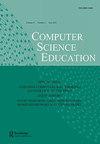面向五、六岁儿童的排序和算法设计学习进程,与教育机器人互动
IF 2.2
Q1 EDUCATION & EDUCATIONAL RESEARCH
引用次数: 0
摘要
摘要计算思维(Computational thinking, CT)是每个人参与公民社会都应该培养的一种基本技能和一种新的素养形式。排序和算法思维是CT的核心。这项研究调查了在哥伦比亚一所幼儿园就读的幼儿如何发展CT技能。目的开发一种适合幼儿学习的排序和算法设计方法。这一目标的补充是,确定儿童面临的挑战,以便使用算法思维进入更复杂的解决问题的方法。方法14名5 ~ 6岁学生参与本研究。这些孩子参加了不插电学习活动,并通过BeeBot解决了两组挑战。我们用扎根理论的方法来分析他们是如何解决这些算法思维活动的,以及他们在这个过程中面临的挑战。我们的研究结果提出了四种越来越复杂的方法来解决这些活动:逐步分解,简单分解,高级分解和完整的算法设计。我们还发现学生们在进行这些活动时面临着不同的挑战。这些挑战可能与关键的认知技能有关。这些结果将使教育者能够支持学生学习CT。这些结果也为儿童早期认知技能和CT活动之间的关系提出了新的问题。我们要感谢Mariana Arboleda、Gabriela de la Rosa、Roxana Quintero、Britny Velasquez、Gisella Jassir和angsamicica Carrasquilla对所有数据收集的支持。披露声明作者未报告潜在的利益冲突。这项工作得到了哥伦比亚富布赖特基金会和弗吉尼亚大学全球研究与创新中心的支持。本文章由计算机程序翻译,如有差异,请以英文原文为准。
Towards a learning progression of sequencing and algorithm design for five- and six-years-old children engaging with an educational robot
ABSTRACTBackground and Context Computational thinking (CT) is a fundamental skill and a new form of literacy that everyone should develop to participate in civic society. Sequencing and algorithmic thinking are at the core of CT. This study looked into how young children enrolled in a kindergarten in Colombia develop CT skills.Objective This paper aims to develop a learning progression of sequencing and algorithm design for early childhood. This goal is complemented by identifying the challenges children face to advance into more sophisticated approaches to problem-solving using algorithmic thinking.Method Fourteen five- and six-year-old students participated in this study. These children participated in unplugged learning activities, and solved two sets challenges with the BeeBot. We used a grounded theory approach to analyze how they solved these algorithmic thinking activities and the challenges they faced in this process.Findings Our results suggest four increasingly sophisticated approaches to solving these activities: step-by-step, simple decomposition, advanced decomposition, and full algorithm design. We also found different challenges students faced when working on these activities. These challenges can relate to critical cognitive skills.Implications These results will enable educators to support student learning about CT. These results also open new questions about the relationship between cognitive skills and CT activities in early childhood.KEYWORDS: Computational thinkingearly childhoodlearning progressionsequencingalgorithmic thinkingvisuospatial skills AcknowledgmentsWe would like to thank Mariana Arboleda, Gabriela de la Rosa, Roxana Quintero, Britny Velasquez, Gisella Jassir, and Angélica Carrasquilla for all the data collection support.Disclosure statementNo potential conflict of interest was reported by the authors.Additional informationFundingThe work was supported by the Fulbright Colombia and Center for Global Inquiry and Innovation at theUniversity of Virginia.
求助全文
通过发布文献求助,成功后即可免费获取论文全文。
去求助
来源期刊

Computer Science Education
EDUCATION & EDUCATIONAL RESEARCH-
CiteScore
6.90
自引率
3.70%
发文量
23
期刊介绍:
Computer Science Education publishes high-quality papers with a specific focus on teaching and learning within the computing discipline. The journal seeks novel contributions that are accessible and of interest to researchers and practitioners alike. We invite work with learners of all ages and across both classroom and out-of-classroom learning contexts.
 求助内容:
求助内容: 应助结果提醒方式:
应助结果提醒方式:


